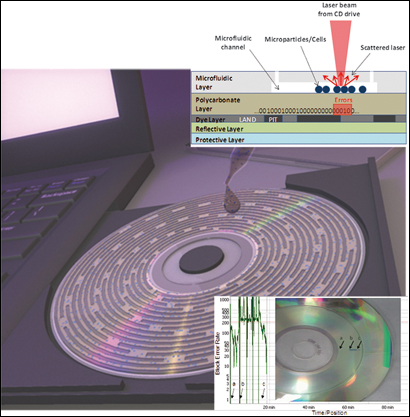
Cells in the microfluidic channels interfere with the laser beam in a standard CD drive and cause errors in reading and decoding the digital data previously burned on the CD
A digital compact disc integrated with a microfluidic device to analyse cells has been developed by scientists in the US. The disc can be inserted into a standard computer disc drive for analysis and could be used to diagnose diseases.
Gang Logan Liu and coworkers at the University of Illinois at Urbana-Champaign built a layer onto a CD that converts biological information into digital information to detect the presence of cells and their size and number. Blood cell counting and sizing are often standard medical practices in the diagnosis of diseases such as leukemia, anemia and Aids.
The team made the device by burning an audio file consisting of a repeating sequence of binary numbers onto a CD’s surface. On top of this, they added a microfluidic layer with a channel. They injected small fluid samples of cells into the channel and focused the laser beam from a CD drive onto the disc’s data layer, which reads the binary code. Any particles on the layer interfere with the laser beam, interrupting the code and altering the data readout in graphs of error against time. The size of the response correlates with the cells’ shape, concentration and optical density.
Read the full Chemistry World article online here or go straight to the Lab on a Chip paper:
Microparticle and cell counting with digital microfluidic compact disc using standard CD drive
Syed M. Imaad, Nathan Lord, Gulsim Kulsharova and Gang Logan Liu
Lab Chip, 2011, Advance Article
DOI: 10.1039/c0lc00451k










